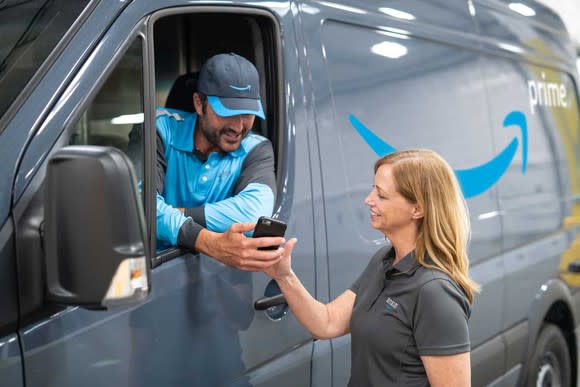Amazon Has a New Plan to Cut Its Shipping Costs
For the last few years, Amazon (NASDAQ: AMZN) has experimented with various solutions to deliver packages the "last mile" from its fulfillment centers to customers' homes. It's long relied on partners like UPS (NYSE: UPS), FedEx (NYSE: FDX), and the United States Postal Service to help in the ever-increasing number of packages it's tasked with fulfilling.
More recently, it started enabling independent contractors to use their own vehicles to deliver packages for Amazon, and it's experimenting with a delivery service for third-party merchants on its Marketplace platform. The latter allows larger merchants to ship directly from their own warehouses and consolidates the expenses associated with selling on Amazon.
Amazon's latest move is called Delivery Service Partners. The program makes it easy for entrepreneurs to start their own logistics companies utilizing the built-in demand of Amazon customers. No need to worry about finding customers -- Amazon says it has enough demand to support hundreds of small logistics businesses.
Amazon will help set up interested parties with Amazon-branded vans, uniforms, and equipment, as well as everything they need to get their businesses off the ground, including insurance. Delivery Service Partners agree to prioritize Amazon's packages, and those using Amazon's equipment will only be able to work with Amazon exclusively.
The move brings Amazon one step closer to being self-reliant when it comes to delivering packages.

Image source: Amazon
Shipping costs
Amazon's shipping expenses have grown extremely high over the last few years as more and more customers join Amazon Prime. Shipping costs from online sales, third-party seller services, and subscriptions (mostly consisting of Prime) as a percentage of revenue have risen dramatically over the last two years.
Data source: Amazon quarterly reports. Chart by author.
In the first quarter of 2016, Amazon spent $0.126 of each dollar it made in revenue for its online retail operations. Last quarter, that number climbed to $0.154 per dollar.
Shipping costs have outpaced revenue growth in recent years for several reasons. As mentioned, Amazon Prime is increasingly popular. That means more customer orders requiring expedited shipping, which can become expensive.
Additionally, the growth of Fulfillment by Amazon, a service Amazon provides to third-party merchants to store and ship their merchandise, has grown increasingly popular over the last few years, as well. That's increased third-party merchant services revenue, but can come with additional shipping expenses to manage inventory across dozens of warehouses throughout the United States.
Perhaps the most important factor in Amazon's shipping costs is the delivery from Amazon's fulfillment centers to customers' homes. UPS and USPS mostly handle those deliveries for Amazon, and Amazon accounts for billions of dollars in revenue for those companies. Amazon says it's not looking to displace those partnerships, but it continues to develop new shipping programs for itself and its third-party merchants.
The future of Amazon
Amazon's move to create its own shipping service is a smart move given the current political environment. President Trump has called into question the profitability of the USPS contract with Amazon, and it could result in a significant rate hike as it's under review this year. Such a hike would be devastating for Amazon, as it uses the USPS for about 40% of its shipping needs, according to analyst estimates.
Amazon still has the option of using UPS or FedEx should a USPS rate hike go into effect, but establishing hundreds of partnerships with small businesses where Amazon sets the rates it's willing to pay is a much more effective hedge.
More importantly, as Amazon builds out its network of fulfillment centers across the country, expands its fleet of cargo planes and delivery trucks, and brings on more Delivery Service Partners, it could start to effectively compete with UPS and FedEx for business outside of its own retail operations. Not only could the new program be a way for Amazon to cut an expense that's climbing faster than revenue, it could be a way for it to eventually add to the top line, as well.
More From The Motley Fool
John Mackey, CEO of Whole Foods Market, an Amazon subsidiary, is a member of The Motley Fool's board of directors. Adam Levy owns shares of Amazon. The Motley Fool owns shares of and recommends Amazon. The Motley Fool recommends FedEx. The Motley Fool has a disclosure policy.

 Yahoo Finance
Yahoo Finance 